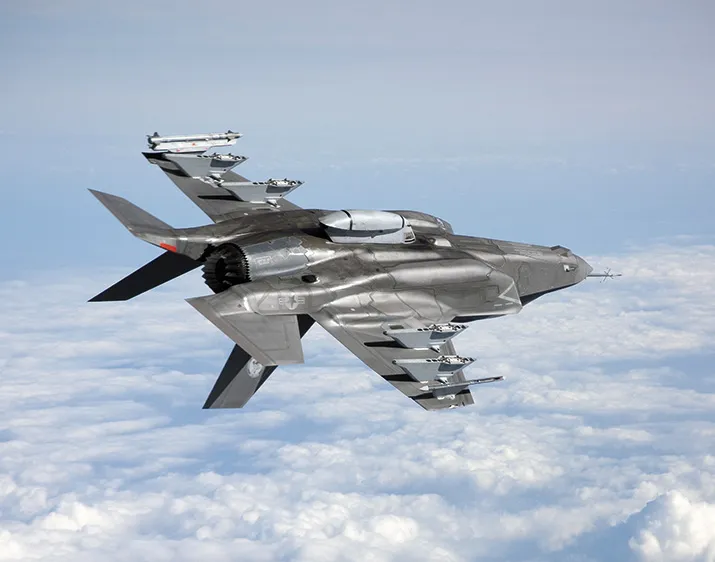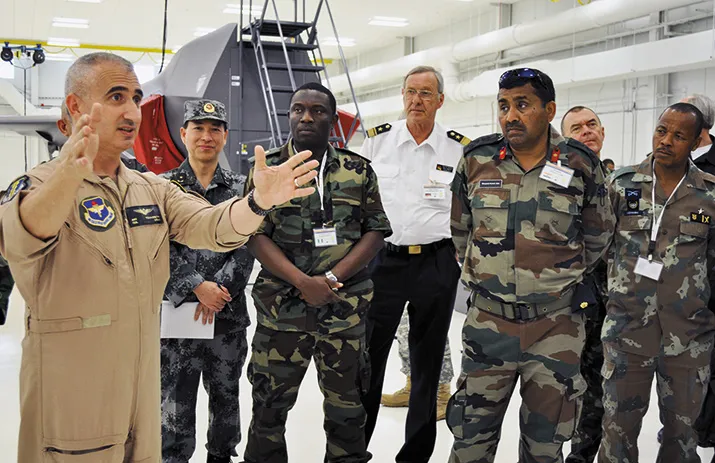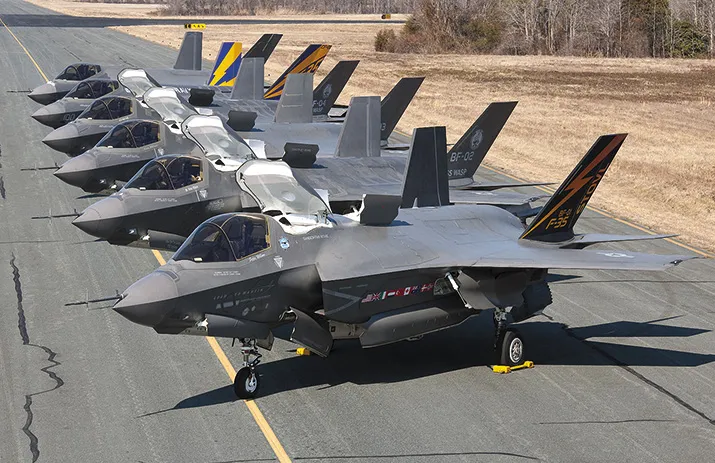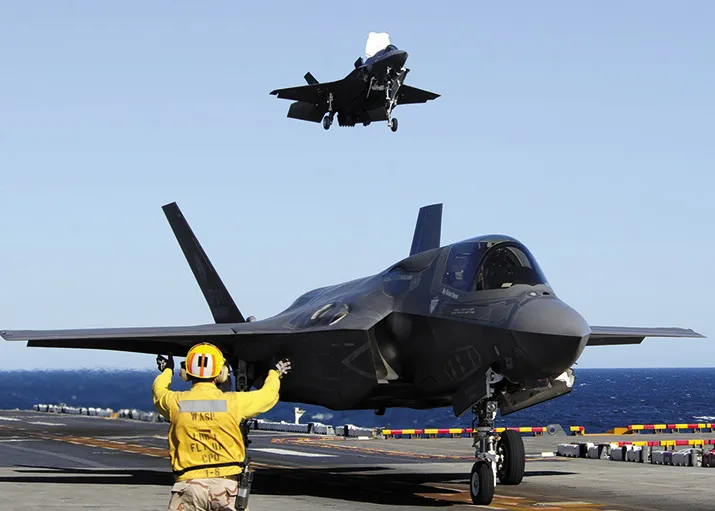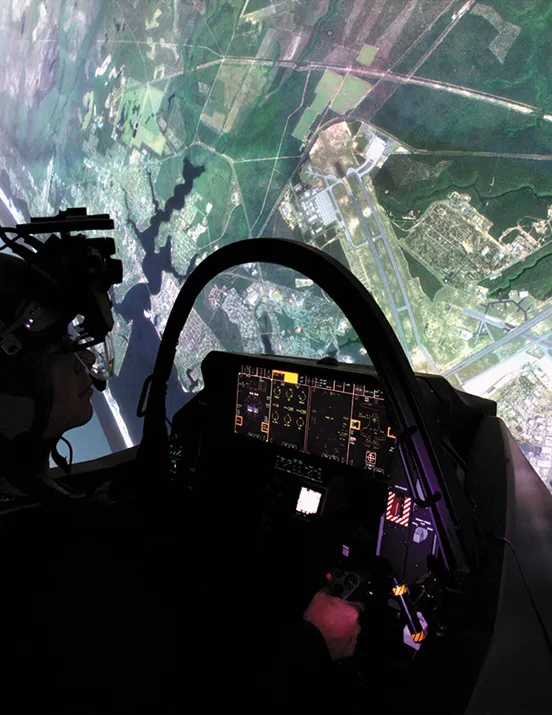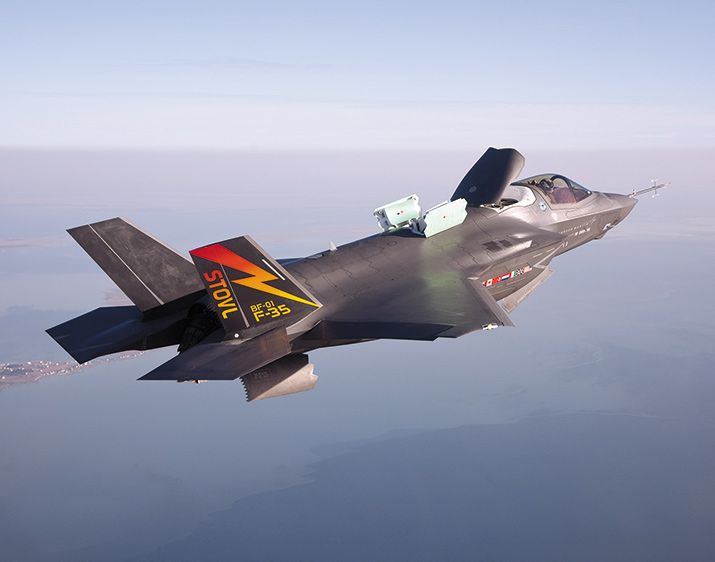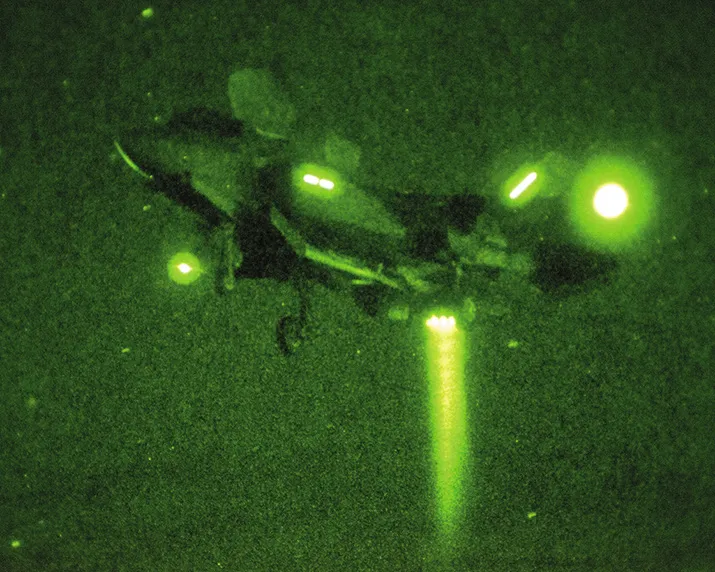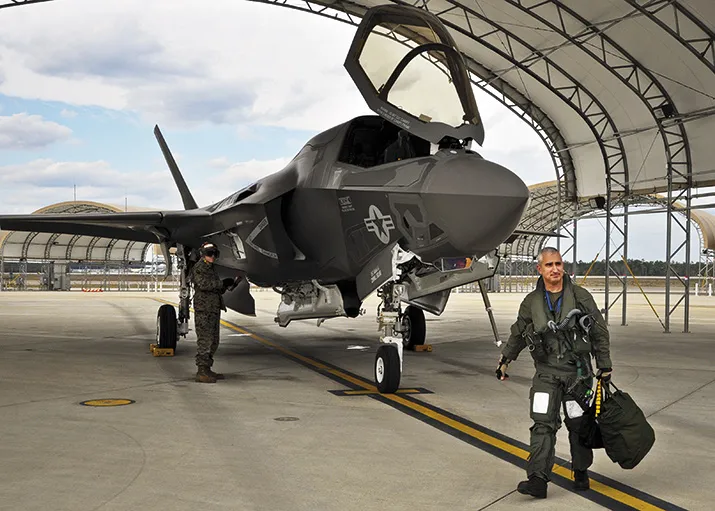The Making of a Joint Strike Fighter Pilot
Welcome to the fifth generation
/https://tf-cmsv2-smithsonianmag-media.s3.amazonaws.com/filer/Making-Joint-Strike-Fighter-Pilot-631.jpg)
At 5:30 A.M., it's still dark as I key in the code to enter the hangar at Eglin Air Force Base, Florida, home of Marine Fighter Attack Training Squadron 501. In the ready room, I glance at the two flat-panel displays behind the duty desk: The first has weather radar, current and forecast weather, and airfield status; the other, today’s flight schedule, including pilots, aircraft, mission, and assigned training area. I am scheduled for a training mission, a formation sortie, with a student on his fourth flight in the Lockheed Martin F-35B Lightning II. He’ll demonstrate close and tactical formation and formation approach maneuvers. The student is talking with the duty officer about the status of today’s divert airfields—places to land if Eglin’s runways are for any reason unavailable. As I walk over to grab a cup of coffee, I let him know that we will brief in five minutes.
As far as squadron ready rooms go, VMFATS-501’s is unusual: All the student and instructor pilots wear either weapons school or test pilot school graduate patches, and in some cases, both. In 2008, to select the first group of pilots to fly production F-35s, a board of senior officers reviewed the records of several dozen F/A-18 Hornet and AV-8B Harrier pilots. The criteria were stringent: 500-plus hours in their legacy aircraft, superior piloting skills, two years of fleet squadron experience, and demonstrated performance as a Marine. (If you consider the investment the Marine Corps was making with these pilots, you can understand the desire to pick those likely to rise through the ranks.) Six students made the cut.
In 1996, I was selected—finally—for the U.S. Navy Test Pilot School. (It was my seventh time applying in four years, proof that “never give up” is sage advice.) About midway through the year-long course, I was asked if I was interested in getting my orders changed from flight testing AV-8B Harriers in California to joining a project team supporting the Joint Strike Fighter. No promises were made about flying—at that time the airplane was just drawings—but with a few months to go until graduation the opportunity to work on a prototype aircraft was too good to pass up.
During the three and a half years I worked on the program, I watched the airplane go from a concept on paper, to a virtual airplane we could fly in a simulator, to a bunch of large pieces in the assembly area at Lockheed’s Skunk Works in Palmdale, California, to something that started to look like an airplane. The introduction to a new fighter is nothing if not gradual. First we were allowed to sit in the cockpit, initially with no power; then with power to the displays; then with the ability to start the engines; and finally as an airplane we could fly. During that phase of the program, I was fortunate enough to fly all three versions of the X-35. I went on to work as an on-site military pilot representative at the Lockheed Martin plant in Fort Worth, then as chief test pilot and commanding officer of VX-23, the Navy test squadron at Naval Air Station Patuxent River in Maryland, tasked with flight testing the F-35B and C. Finally, I ended up at Eglin to help establish the F-35 training center and train the first cadre of pilots and maintainers.
The Joint Strike Fighter program launched in the early 1990s, when the U.S. Air Force, Navy, and Marine Corps set about developing what they called a Common Affordable Lightweight Fighter. The aircraft would replace the F-16, A-10, and F/A-18 in the United States as well as the CF-18 in Canada. A short-takeoff/vertical landing (STOVL) version would replace the AV-8B as well as British Harriers.
By 1996, the government had narrowed the competition to build the new airplane down to Boeing and Lockheed Martin. As drawings became aircraft, the Boeing X-32 and Lockheed Martin X-35 underwent a year-long flyoff. An evaluation team, consisting of pilots and engineers from the Marines, Navy, Air Force, and United Kingdom, split in half so each could focus on just one airplane. No pilot would get to fly both. I was on the evaluation team for the Lockheed Martin entry.
Because the Air Force, Navy, and Marine Corps each had unique requirements, each contractor built two prototypes to demonstrate the three variants. When the X-35A airframes, designed for the Air Force, completed flight testing, they were converted into the STOVL B versions, for the Marines. The X-35C airplane could also have been modified to accomplish the Marines’ short takeoff/vertical landing objectives; the interchangeability demonstrated that the manufacturers had created a single design focused on demonstrating short-takeoff/vertical-landing, common design, and carrier approach.
A test program for a new airplane like the F-35 is complex. To confirm the parameters of takeoff alone, the test pilots must take off day and night, in good weather and bad, with headwinds, crosswinds, and tailwinds. From dry runways, wet runways, and icy runways. From concrete, asphalt, expeditionary matting, and ships. The aircraft must take off at light weight and heavy weight, on conventional takeoffs and short ones, and at a range of speeds. We test to learn what the limits are for each, and to determine how easy or hard it is for a pilot to perform each task. We also tested landing, flying, and delivering weapons with the same variations in conditions.
We discovered a few things that would need to change before the aircraft entered production. On the X-35B’s STOVL variant, the doors above the lift fan had a bi-fold arrangement: They folded and slid outward, creating an opening for air to enter the fan. However, when the airplane was slowed to a hover, the air flowing across the top of the aircraft would not on its own make the turn into the fan efficiently; it needed to be guided. On the production F-35B there is a different arrangement: Instead of two doors sliding open, a single door, hinged aft, lifts up and acts like an air scoop, helping to funnel the air into the fan. But the new design of the lift fan cover created additional challenges for the two auxiliary air inlet doors that sit right behind it. Not all the air is channeled into the fan, and at higher speeds, the air that flows around its raised cover is turbulent, causing the open doors on the auxiliary air inlets to vibrate. The hinges on those doors, therefore, had to be strengthened.
Another change that would be required in the production airplane was in the cockpit controls. The cockpit controls for flying in the X-35B were similar to those in the AV-8B. In that and earlier STOVL aircraft, the pilot has a set of cockpit controls for conventional flight and a separate set of controls for the hover. Typically, the hover control is an additional lever the pilot used to control the thrust vector, so as the aircraft transitioned from conventional flight through the hover, the pilot had to use both hands to manipulate stick, throttle, and thrust vector.
The F-35B has a stick and throttle. They work in four regimes: conventional flight, transition to hover, hover, and vertical landing. No longer does the pilot manage the thrust vector with a separate control. It doesn’t matter whether you are in the A, B, or C model or you’re flying at 500 knots or hovering—you use the same inputs to control the aircraft. If you want to go up, pull back on the stick; if you want to go down, push forward. If you want to go forward or go faster, increase the throttle; if you want to slow down or go backward, decrease it.
A variety of sensors, combined with accelerometers, an inertial navigation system, and GPS, make this happen. The pilot inputs commands via the stick and throttle to tell the airplane where he wants to go. The flight control computer (there are three, for redundancy) translates the pilot’s inputs to adjust the engine thrust, thrust vector, and flight controls.
The F-35s we’re flying at Eglin differ from the X-35 in a third way: They have no head up displays. Instead, the displays have been integrated with our flight helmets; we now wear a helmet-mounted display (HMD) system. Tiny cameras inside the helmet project data on the visor. In addition to basic flight information—speed, altitude, attitude—the display continuously provides the status of targets, weapons, navigation, threat, and critical aircraft information. The helmet has a built-in night-vision camera and can also display infrared views from cameras mounted outside the aircraft, so when, for example, you look down at the floor of the cockpit, you see the ground below in the visor display.
Most legacy helmet-mounted displays are monocular. The F-35 HMD is binocular. With a monocular system, one eye is giving your brain information from outside the HMD. With a binocular system, your brain gets what your eyes are seeing in the HMD. The new technology has run into some problems, such as how fast the computers need to process an image and display it to the pilot. The time lag is measured in milliseconds; just how many is the key issue. If the delay is too long and your brain registers the difference, what you see in the display doesn’t match what you see in the real world. Because this is the first use of an advanced system, we have to learn what the human eye and brain can tolerate.
The final difference between the production and test versions of the aircraft has to do with weight. One of the key attributes of a STOVL aircraft is its ability to land vertically with as much weight as possible, so the aircraft can return with unexpended weapons or extra fuel or both. In order to increase the weight the aircraft can land with, the designers must either increase engine thrust or decrease aircraft weight. In the F-35B, the engine thrust was fixed; the only way to achieve the performance the government wanted was to decrease weight. You just get rid of things you don’t really need. But how do you decide what you don’t need? There were numerous meetings, engineering discussions, and emotional debate. As part of the perpetual battle to keep weight down, we lost the pilot’s ability to extend the boarding ladder from the cockpit, which is about 12 feet above the ground. But pilots in other airplanes have lived without it, so we had to let it go.
The first step in becoming a Joint Strike Fighter pilot is familiar to anyone who has learned to fly: ground school. In Marine Fighter Attack Training Squadron 501, ground school consists of academics and simulators that teach the pilots how to operate and fly the aircraft. When I learned to fly the AV-8B, I got a stack of books. I read the books, sat in classes, and practiced in a basic cockpit trainer. My student got a laptop computer with a stick and throttle to plug into it, just like the stick and throttle in the F-35. His classroom is fully electronic. He learns by doing. When we are teaching him about the fuel system, he sees the fuel system, watches the fuel burn down, and views the fuel display on his computer exactly as it appears in the aircraft. When he is in the classroom, his desktop trainer has a touch screen display, a stick and throttle, and a headset and microphone so he can use voice activation to command certain functions—all precisely mimicking the systems in the airplane. After three weeks in the classroom, he graduates to the Full Mission Simulator, an F-35 cockpit that slides into a large dome. Multiple high-definition cameras project on the surface of the dome images of the scenes around the airplane. Although the simulator does not move, it provides realistic video and sound. The simulator is vital, because the F-35 does not have a trainer or two-seat variant. When a student first flies the airplane, he or she is solo.
Going out to taxi the airplane may not sound challenging, especially given the caliber of pilots we selected for initial training. We added taxi familiarization to the syllabus to give students a chance to sit in the aircraft when they were not under pressure to fly. They are strapped in, the engine is running, and for the first time, they get to experience the real thing. In the simulator, the student “sees” the airplane. It doesn’t rumble or vibrate; the computer-generated sounds are realistic but not quite true. When the student puts on his flight gear, straps into the cockpit, starts the engine, and begins to creep forward, it’s a real thrill.
The F-35 is a digital airplane: There are no gauges, dials, or analog displays. The throttle and stick enable the pilot to fly, and, because both are loaded with buttons and switches to control sensors, weapons and target selection, communications, and autopilot, among other things, we’ve given the control interface a name: Hands on Throttle and Stick, or HOTAS. The pilot also uses a large touch-screen display that takes up almost the entire front panel in the cockpit. The pilot can configure the display with up to 14 windows of information, and one touch of the quick-access menu bar can open another 10 windows displaying aircraft systems. Remember, the student had repeated exposure to these interfaces both in the classroom and in the simulator.
The F-35 is in its seventh year of flight test and still has a few more years to go. We are buying and fielding F-35s while the aircraft is still in development, so until testing is complete, we fly the operational aircraft with limitations on speed, angle of attack, how many Gs we can pull, and the use of certain systems and sensors.
This approach to military aircraft procurement, known as concurrency, is controversial. Why would anyone start training with an airplane that was only partially capable? Because we are building understanding, familiarity, and compatibility. Center stick pilots need to become side stick pilots. Push button and analog pilots need to become touch screen and digital pilots. Head-up-display pilots need to become helmet-mounted-display pilots. Fourth generation pilots need to become fifth generation pilots. We’re still learning what the F-35 can do, and we need people who know the airplane and can continue to drive it to its ultimate performance.
Colonel Art Tomassetti retired from the U.S. Marine Corps in August after 27 years of service and 3,200 hours in 40 types of aircraft. He served two tours as an AV-8B pilot, including combat missions in Operation Desert Storm.
